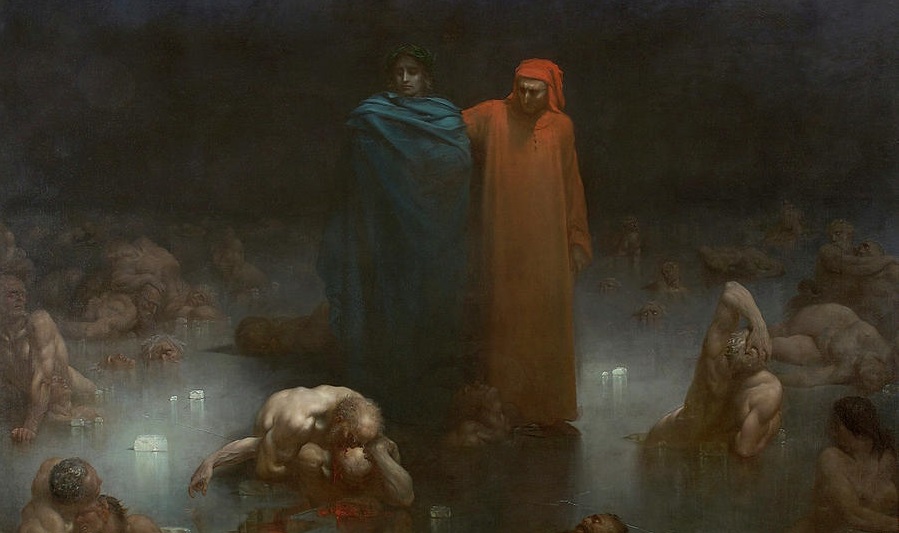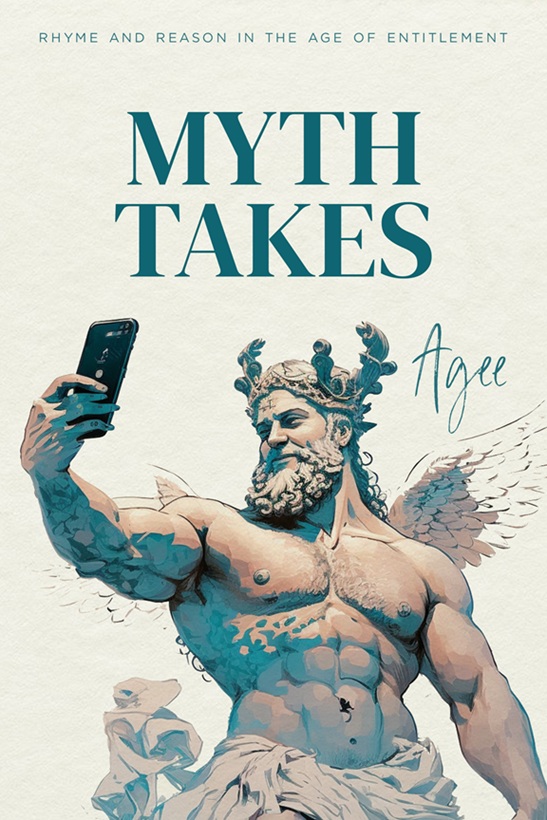.
On Professionally Hesitant Poets
O, for a Muse of fire, that would ascend
The brightest heaven of invention!
—Shakespeare, Henry V
Old Vergil guided Dante to the place
Where uncommitted, opportunist souls
Swarm back and forth, through tracts of vacant space,
Unfit for heaven, or infernal coals.
Neither good nor evil moved them, so
Deprived of all distinctiveness and rank,
They drift in an eternal, vagrant flow,
Each face a pallid, characterless blank.
How like those poets whose anemic pens
Dribble out vague impressions, or devise
A verse where dim uncertainty contends
With unshaped thought, and tentative surmise:
A poetry of reticence and dread—
So elegant, so subtle, and so dead.
—from Cumberland Poetry Review
.
.
Coastal Scene
A herd of walrus: sprawling bloated bags
On dun rocks; breakers plunging in white foam;
Brown kelp entangled in the sea-washed crags—
Wet hair indocile to the pleading comb.
A splash of frenzied movement—scale and fin
Seen just below the surface, open maw.
A whirlpool for some seconds, then a thin
Red wake of bubbles intermixed with gore.
Over and done with. Calm again the deep.
The rocks unmoved, kelp clinging tightly to them,
And lolling in the surf’s mist, half-asleep,
The walrus imperturbable as phlegm.
—from Cumberland Poetry Review
.
.
The Yellow Leaf
Against the curbside, flatter than a stamp,
One perfect yellow leaf from somewhere blown,
Composing, in the afternoon’s cool damp,
Its counterpoint to gray granitic stone,
Looks on a flowing gutter with its freight
Of sodden cigarette butts, paper scraps,
Dissolving newsprint, gasoline, a spate
Of broken sticks and coffee lids. Perhaps
Its eight rhumbs, like a compass rose, reach out
To mark direction in this tangled flux
With lodestar fixity, resolving doubt
By true convergence at a common crux.
Such is a yellow leaf. At least it seems
To function so above the gutter’s streams.
—from Pivot
.
Poet’s Note
These pieces are quite old, but I thought they might be of some interest. The first is a Shakespearean sonnet that conjoins Dante’s account of the neutral souls in the Vestibule of Hell (Inferno, canto 3) with my criticism of the tendency in modernist poetry to be vague, confusing, and indirect. The second poem is a deliberate composition that avoids any verb of being, and depends for its effect solely on nouns, adjectives, and participial forms. The third is another Shakespearean sonnet that depicts something utterly simple (a leaf on a curbside). Its octet is one long sentence, and the poem employs a single similitude—the likening of the yellow leaf to a compass. These poems were written purely as exercises.
.
.
Joseph S. Salemi has published five books of poetry, and his poems, translations and scholarly articles have appeared in over one hundred publications world-wide. He is the editor of the literary magazine TRINACRIA and writes for Expansive Poetry On-line. He teaches in the Department of Humanities at New York University and in the Department of Classical Languages at Hunter College.















Terse, descriptive, captivating verse that serves to prove that well-written formal poetry can be both more liberating and more expressive than anything found in the so-called free-verse/prose-poetry genre.
I’m particularly struck by the clever choice of the word “granitic” and the marvelous itemization of stuff that forms the gutter-backdrop for the yellow leaf.
As for Dante, I can see him nodding approval of the inclusion of hesitant, insipid poets in Hell’s vestibule. He was, after all, one of the least hesitant and least PC poets in the pantheon.
Thank you, James. I wrote “The Yellow Leaf” at a time when I was deeply interested in the Imagist poets of the early 20th century, but when I showed it to others who knew that period, they argued that the poem had far too many adjectives like “granitic” to be an imagist poem. That’s when I began to realize that modernism — like all forms of liberalism — is all about imposing the constraints of theory on perfectly OK reality. I never changed the poem.
I always attempt to absorb your poetic wisdom and am in agreement with your not-so-subtle jabs at modernistic mayhem, as in your comments. After reading “Coastal Scene” and “The Yellow Leaf,” I am convinced you could write an amazing poem about a toothpick!
Dear Roy, many thanks for your kind words. I don’t know about a toothpick, but since I collect old swizzle-sticks I might try one on that subject.
Splendid poems all three, Joe, with much to savor and much to.ponder. I especially like the sonnet’s harsh assessment of vague and vanilla poetry. “Anemic pens which dribble out vague impressions” is deliciously cutting. I also admire the poetic language snd imagery which you’ve used to frame that simple yellow leaf. You’ve taken something normally unnoticeable and made it beautiful and memorable.
Thank you, Brian. At the time of writing I had just learned about what a “compass rose” meant, and what the eight rhumbs of direction were. Seeing that perfect yellow leaf on the edge of a gutter immediately clicked with my thoughts, and generated the poem.
Like it all but love On Professionally Hesitant Poets: superb writing and a real hammer blow in the last line. Great to see this resurrected from the past – real poetry always endures, is always contemporary.
Joe, these are beautifully crafted inspirational poems that sing. I aim to make music just like this and will most certainly be taking a yellow leaf from the gutter’s streams. Thank you!
Dear James and Susan —
Many thanks for the appreciative comments. All the best to both of you.
I particularly liked The Yellow Leaf and the contrast between the beauty of leaf litter and the ugliness of human litter.
Thank you, Paul.
Joe, these are really good. I would love to be able to write such great poems about even the most mundane things as you’ve done. I couldn’t begin to imagine what I would write about a leaf, for example, but you’ve more than risen to the challenge.
Many thanks, Joshua. Sometimes it’s harder to write one of these short, small pieces than it is to compose something longer. The reader can take in everything quickly, and therefore there can be no flaw.
“Coastal Scene”—a striking sketch, reinforcing the value of a concentrated focus on the verbal pyro-techniques of Hopkins, Dickinson, Eliot, and Stevens. These twelve iambic pentameters, a microessay on wild (“indocile”) life, throughout break-ing in/to thoughtful observation in a dense excerpt on existence. As exact as Roethke, as intense as Plath, with “phlegm” the high point of perspicacity.
Thank you, Bruce. Apart from the image of the walrus herd as “bloated bags,” the line “Wet hair indocile to the pleading comb” is the only similitude in the poem.
Joe, I like “The Yellow Leaf” because your simile of the compass rose immediately brought to mind the compass rose armbands I wore in the front line of Women’s Army Corps marching units. The armbands were solid black with a gorgeous compass rose embroidered in gold. Wearing them was a temporary privilege–for squad leaders in basic training, and as company guide for parades. The wearers determined the direction and regularity of the formation. This could be my minimal topic for a poetic exercise! Yours keeps the reader “eyes right” in the quatrains, with “platoon halt” at the couplet.
I’m glad it was pleasing, Margaret. I think the compass rose is one of the most beautiful and elegant symbols ever conceived by the human mind. The fixity, the pure symmetry, the solid connection with the real world, and the universality — they all set you “in a place,” while at the same time letting you know that your particular place rests within a much wider context.
As usual, the left has a simmering hatred for this kind of symbol. There is a movement afoot in geographical circles to make all future globes and Mercator maps UPSIDE-DOWN, so that what we will see on these guides will have the south at the top, the north at the bottom, east and west reversed, and all land masses in a completely unrecognizable shape. The reason? The way the globes and maps are now “privileges” the northern hemisphere and denigrates the southern, and this is clearly classist, racist, imperialist, culturally ethnocentric, BLAH, BLAH, BLAH. You know the usual bullshit that liberals spout.
A Geography professor in my school has one of these imbecilic maps hanging in his office. He’s very proud of it.